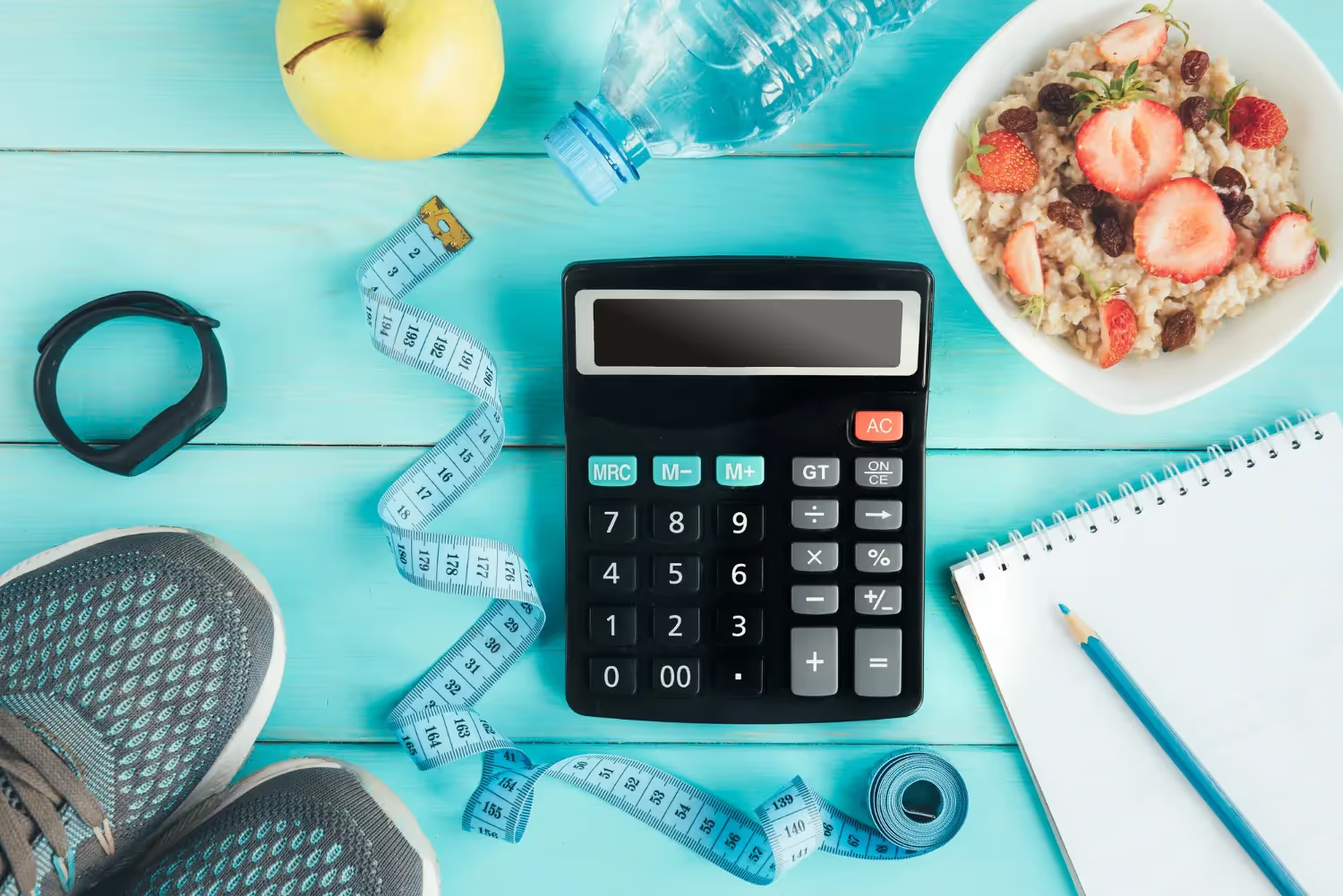Yoga Calories Burned Calculator For Women
Our yoga calorie calculator helps women gauge the amount of calorie burns and the effects it has on their metabolic health.
In this article, we introduce the yoga calories burned calculator. We cover why you should track calories during yoga, user instructions, the best foods to pair with yoga practice, and more.
What Is a Yoga Calories Burned Calculator for Women?
The yoga calories burned calculator is designed to estimate how many calories women burn in a yoga class based on weight, class duration, and type of yoga.
Why Track Calories Burned During Yoga?
Tracking the amount of calories burned during exercise can help women plan their energy balance, supporting fat loss, weight maintenance, and or weight gain.
Each of us has a basal metabolic rate, which is the amount of calories (energy) our body burns at rest. Calorie intake through food, and energy expenditure through exercise directly impact weight loss and weight gain.
For example, a surplus of calories will lead to weight gain, a deficit will lead to weight loss, and consuming the amount of calories equal to your basal metabolic rate will lead to weight maintenance.
Tracking calories burned during yoga can help manipulate balance, giving women control over their health and wellness goals.
How to Use the Yoga Calories Burned Calculator
- Enter Your Body Weight (Lbs or Kg): Weight influences the amount of calories burned during your workout.
- Select Your Yoga Style (Hatha, Vinyasa, Hot, Yin, Etc.): Each style of yoga has different intensity levels, and selecting your style will influence your energy expenditure during the session.
- Input The Duration Of Your Class: Duration affects the total amount of calories burned during your yoga session. The longer the session, the more calories burned.
- Click Calculate To See Your Estimated Calories Burned: Once you have input your information, this will calculate your calories burned.
What Are Macros?
Macros, also known as macronutrients, refer to carbohydrates, proteins, and fats. These are vital for our body’s physiological process with each serving a biochemical role within the body. Below we explore each macronutrient. For more information consider reading, What Are Macros.
Carbohydrates
Carbohydrates are the body’s main energy source. Containing 4 calories (kcal) per gram, they are shown to make up 45–65% of a traditional diet and are shown to raise blood glucose, stimulate insulin, and metabolize cholesterol and triglycerides.
Protein
Protein plays a major role in many of the body’s systems and is most commonly known for building and preserving lean muscle mass. Protein makes up approximately 10–35% of daily calorie intake, containing 4 kcal per gram. Studies show that it can also improve fullness, and increase metabolism. This is why so many health professionals stress hitting your daily protein goals.
Fats
Fats make up 20–35% of our daily calorie intake. Containing 9 kcal per gram, they are dense energy sources capable of nutrient absorption, protecting organs, and producing hormones. However, this does not mean all fats are created equal.
For example, unhealthy fats such as trans fats and saturated fats are linked to coronary heart disease, stroke, and type 2 diabetes. Meanwhile, healthy fats such as unsaturated fats (monounsaturated and polyunsaturated) are proven to have inverse effects, reducing cardiovascular disease, lowering bad cholesterol, and supporting cell health, and immune function.
Why Tracking Macros + Movement Works
There is a reason why health professionals track macronutrients and movements — because it works! As mentioned, tracking macronutrients allows greater nutritional control. For example, hitting daily protein targets increases fullness and metabolism, which can lead to greater fat loss and preservation of muscle mass.
Combined with yoga, it can reduce cravings and maintain a healthy weight. When fused with resistance training and a calorie surplus, it can increase muscle. To learn more, read this amazing resource on how to count macros for women.
Macros vs. Calories: What's the Difference?
Macronutrients and calories are vital for nutrition. Calories are used to show the total energy content of food, while macronutrients show the distribution of carbohydrates, protein, and fats.
To illustrate the difference in their purpose we will compare chicken breast and tofu, two foods with similar amounts of calories and different macronutrients.
Chicken breast and tofu contain similar amounts of calories. However, as you can see the breakdown of macronutrients is very different.
Chicken breast contains almost double the amount of protein as tofu and fewer carbs and fat. However, this doesn’t mean tofu is bad food, rather it simply has a different composition of macros which can help be used to fit in with your daily macronutrient intake.
For example, when tracking your macronutrients, sometimes you need foods that provide a balance of macronutrients to maintain energy levels. Tofu can easily fill that need, providing a considerable boost to protein, a small amount of carbohydrates, and a great serving of healthy fats (omega-6 and omega-3). To learn more, read Counting Macros vs Calories.
Best Foods to Pair with a Yoga Practice
There are several foods that can help provide energy, aid recovery and support the body during yoga. Below, we list the best foods for easy macro counting, categorizing them into carbohydrates, protein, and fats to not only help you improve your yoga but also achieve amazing results.
Carbohydrates
Protein
Fats
Calorie Needs for Women Who Do Yoga Regularly
Calorie needs for women during yoga vary depending on the individual’s training goals. While yoga isn’t typically performed for its energy expenditure, it still burns calories which must be compensated for with correct nutrition.
For fat loss, a calorie deficit is required. This is when we consume fewer calories than our basal metabolic rate (amount of calories the body uses at rest).
The recommended daily calorie intake of 2,000 kcal per day. This is the amount of calories the body requires to function at rest. Therefore, to maintain weight, calories must meet these requirements and to lose fat they must be below this amount.
However, when yoga is added, it can create a further deficit, as sources suggest a single yoga session can burn between 200–600 kcal per hour depending on the style and intensity. This would create a calorie deficit of 200–600 kcal.
For example:
- Daily Calorie Intake Yoga Session Energy Requirement = Calorie Deficit
- 2000 kcal 200 – 600 kcal = 1,800 – 1,400 kcal
This would provide a manageable deficit for steady weight loss. However, if the goal was to maintain weight, the 200–600 kcal would need to be made up through nutrition to eliminate the deficit.
Performing yoga sessions in a deficit can be challenging. However, this is achievable with the correct balance of complex carbohydrates, protein, and healthy fats to maintain energy levels, satiety, and overall health.
For more information surrounding macronutrient control and different requirements by age, read these helpful resources:
Can Yoga Help Menopausal Weight Loss?
Menopause is a challenging time for women. As reproductive hormones decline, they experience physiologic changes resulting in symptoms such as hot flashes, night sweats, muscle aches, joint pain, increased appetite, and sudden weight gain.
Yoga has several benefits which can help alleviate menopause symptoms and aid in weight loss. Research shows that yoga improves menopause symptoms including sleep quality, anxiety, body mass index, and blood pressure.
Additionally, yoga is shown to promote mindfulness which can manage emotional eating and encourage healthy eating. This can create a better understanding of cravings and foster a better relationship with food, making it easier to deal with appetite and weight gain. For more information, read these excellent resources:
How to Track Your Calories and Macros Holistically
Whether you’re tracking your calories and macronutrients for yoga or life, it is important to think about it holistically. Correct nutrition is often adopted to address weight-related issues. However, its application goes far beyond this, providing support to energy levels, mood, and hormones.
Thankfully, tracking nutrition has never been easier as many nutrition apps contain calories and macronutrient capabilities. This combined with extensive food databases makes tracking easy. If you would like to discover the benefits of tracking macros, read 10 Benefits of Tracking Macros.
Sources
- Espinosa-Salas, S. & Gonzalez-Arias, M., 2025. Nutrition: Macronutrient Intake, Imbalances, and Interventions. In: StatPearls [Internet]. Treasure Island (FL): StatPearls Publishing. https://www.ncbi.nlm.nih.gov/books/NBK594226/
- Holesh JE, Aslam S, Martin A. Physiology, Carbohydrates. 2023 May 12. In: StatPearls [Internet]. Treasure Island (FL): StatPearls Publishing; 2025 Jan. PMID: 29083823. https://pubmed.ncbi.nlm.nih.gov/29083823/
- Halton TL, Hu FB. The effects of high protein diets on thermogenesis, satiety and weight loss: a critical review. J Am Coll Nutr. 2004 Oct;23(5):373-85. doi: 10.1080/07315724.2004.10719381. PMID: 15466943. https://pubmed.ncbi.nlm.nih.gov/15466943/
- de Souza RJ, Mente A, Maroleanu A, Cozma AI, Ha V, Kishibe T, Uleryk E, Budylowski P, Schünemann H, Beyene J, Anand SS. Intake of saturated and trans unsaturated fatty acids and risk of all cause mortality, cardiovascular disease, and type 2 diabetes: systematic review and meta-analysis of observational studies. BMJ. 2015 Aug 11;351:h3978. doi: 10.1136/bmj.h3978. PMID: 26268692; PMCID: PMC4532752. https://pmc.ncbi.nlm.nih.gov/articles/PMC4532752/
- Liu AG, Ford NA, Hu FB, Zelman KM, Mozaffarian D, Kris-Etherton PM. A healthy approach to dietary fats: understanding the science and taking action to reduce consumer confusion. Nutr J. 2017 Aug 30;16(1):53. doi: 10.1186/s12937-017-0271-4. PMID: 28854932; PMCID: PMC5577766. https://pmc.ncbi.nlm.nih.gov/articles/PMC5577766/
- Wang, H., Liu, Y., Kwok, J.Y.Y., Xu, F., Li, R., Tang, J., Tang, S. and Sun, M. (2025) ‘The effectiveness of yoga on menopausal symptoms: A systematic review and meta-analysis of randomized controlled trials’, International Journal of Nursing Studies, 161, p.104928. Available at: https://doi.org/10.1016/j.ijnurstu.2024.104928.
- Watts AW, Rydell SA, Eisenberg ME, Laska MN, Neumark-Sztainer D. Yoga's potential for promoting healthy eating and physical activity behaviors among young adults: a mixed-methods study. Int J Behav Nutr Phys Act. 2018 May 2;15(1):42. doi: 10.1186/s12966-018-0674-4. PMID: 29720214; PMCID: PMC5932774. https://pmc.ncbi.nlm.nih.gov/articles/PMC5932774/



%20Calculator%20for%20Women.avif)

